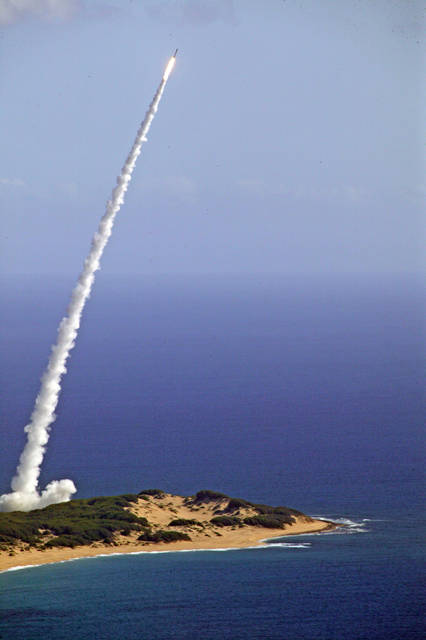LIHUE — Scientists, conservationists and other members of the Kauai community sent their manao to the U.S. Navy on its 5-year plan for training and testing in the Hawaii-Southern California complex, beginning in 2018.
The comment period recently closed on the Navy’s Hawaii-Southern California Training and Testing Environmental Impact Statement/Overseas Environmental Impact Statement (EIS/OEIS) for munitions testing and training.
Inadequacies in the protection of marine life was a running theme in comments regarding the plan, which is an update of the 2013 Hawaii-Southern California Training and Testing EIS/OEIS.
Kauai biologist Katherine
Muzik submitted 534 pages of
written testimony to the Navy on its plan, detailing her concern for coral and other marine life, mainly due to the use of sonar and munitions testing.
“Coral polyps are sensitive animals,” she wrote in her testimony. “They cannot escape the injurious impacts of sonar. Continuous sonar day and night, for five years, will cause coral polyps to continually contract, not feed or reproduce, and to die.”
She continued: “I invite the Navy to listen to the voices of Hawaii youth, to the voices of whales, dolphins, seals and turtles, to the silence of deep sea corals, and all of us who understand the terrible significance of your crippling and noisy attacks on these innocent creatures.”
Muzik also commented during the Navy’s Nov. 8 community meeting in Lihue, where Navy representatives explained its plan and accepted feedback.
Kauai Chamber of Commerce President Mark Perriello was also at that meeting, and read through the EIS/OEIS.
The chamber did not submit written comments on the EIS/OEIS, but Perriello supports the staff members at Kauai’s Pacific Missile Range Facility, and said they do a stand-up job.
“The men and women at PMRF take their environmental stewardship responsibilities very seriously,” Perriello said.
Rep. Dee Morikawa (D-16) said she did not submit comments on the EIS/OEIS, but “with the North Korea threat, testing and training is critical.”
The whale conservationist group Kohola Leo called the EIS/OEIS too vague.
“It is very difficult to comment on this Draft EIS because there are so very few specifics,” the Kohola Leo testimony reads.
The testimony continues: “First and foremost, we feel that there should be a separate environmental analysis of the Rim of The Pacific (RIMPAC) international war exercises. Second, we do not accept that posting an observer on the bow is mitigation for active sonar and explosives. The people of Kauai have a right to know what they are doing besides vague references to sonar and explosions.”
Robin Baird, who has conducted research on populations of many whale and dolphin species in Hawaii waters with Cascadia Research, said there is no doubt the Navy will continue to use mid-frequency active sonar (MFAS) in the areas.
“The question is whether they are doing enough to mitigate the effects of MFAS on sensitive species,” Baird said.
He points out the EIS/OEIS has no restrictions on helicopter-deployed MFAS, despite recent studies that show that Cuvier’s beaked whales react more strongly to helicopter-deployed MFAS than ship-deployed sonars.
“The primary mitigation measure proposed (aerial surveys) is insufficient to minimize impacts on marine mammals for several reasons, including inappropriate sea states for detection of marine mammals, as well as potentially using an inappropriate aerial survey platform,” Baird wrote in his testimony, which was submitted through Cascadia Research.
Baird suggested considering additional monitoring requirements other than the collection of acoustic data through the PMRF hydrophone range.
One of those methods is using some of Cascadia Research’s own data-collecting methods, as the group has previously worked with the Navy to deploy satellite tags on cetaceans at PMRF prior to submarine commanders courses.
The goal is to utilize tag data to examine exposure to acoustic impacts.
“This approach, in addition to proposed monitoring efforts, would provide additional information on the exposure and potential responses to activities,” Baird wrote.
The purpose of testing and training activities in the Hawaii-Southern California area is to “maintain a ready force,” according to Navy representatives.
All comments on the document will be addressed in the Final EIS/OEIS, the release date of which has not been announced.



Please see the forest through the trees. Do you really think any other country goes to the lengths the US Navy does, to mitigate negative environmental impact? The last thing PMRF wants is the “Culture Mafia” and the crazy 1960 hippies, aka “Granolas” on this island screaming “murder” over a dead whale or a dead Sea Lion washing ashore on the west side of the island. You have more important priorities than this “every 4 months” article on how the Navy is destroying the waters off Kauai. Stop the madness!
If the effects of sonar on coral, as stated in this article, were peer reviewed, evidence based facts, then this brand new idea would be a death knell for this Navy training issue and you would read all about it on the front page of the NY Times.
Since important environmental organizations like The Nature Conservancy are actually using sonar for the task of mapping coral reefs, I sincerely doubt whether any of this is evidence based!
Since when has the Chamber of Commerce given a you-know-what about environmental concerns? What a joke- they (the military) are not talking about protecting our precious oceans and the life therein, they’re trying to negotiate acceptable “kill levels” as if it’s ok to slaughter a certain number of whales and dolphins as long as there are a few of them left to carry on in a very questionable future. Thanks to Kohola Leo and everyone else who is fighting for the health of our oceans.